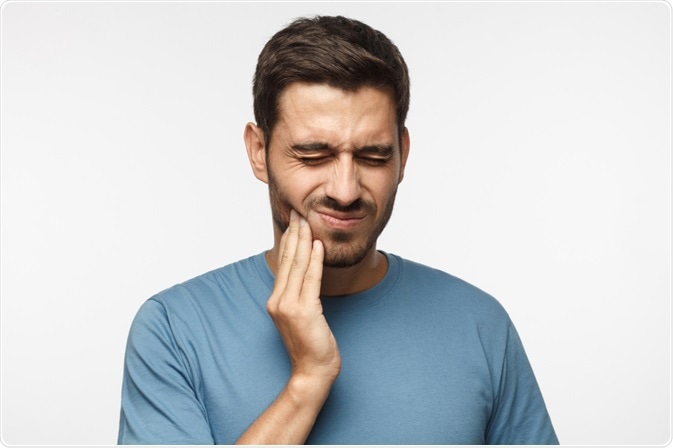It is imperative to seek dental treatment following the onset of dental pain. However, some home care treatments can soothe dental pain till professional treatment is available.

Damir Khabirov | Shutterstock
Why am I experiencing toothache?
Statistics reveal that worldwide 60-90% of school children suffer from dental caries; the most common infective human disease. Untreated tooth caries is one of the major reasons for both chronic and acute toothache.
The second leading cause of dental pain is periodontal (gum) disease. P gingivalis and A. actinomycetemcomitans are the two bacteria which primarily cause periodontal disease.
Other causes of toothache include:
- Food lodgment between two teeth when there is a large interdental space (space between two adjoining teeth),
- Periapical abscess (pus at the apex of the tooth) or abscess in the gums,
- Tooth trauma which may be due to an external injury or involuntary grinding of teeth,
- Fracture of the tooth or tooth root,
- Slow splitting of a tooth,
- Pain caused by eruption of primary or permanent teeth,
- Pain due to the eruption of the third molar teeth because of limited space in the dental arch,
- Referred dental pain because of sinus infection or cardiac ischemia,
- A broken dental filling exposing the internal structures of the tooth.
Toothache may have a sudden onset, and the pain may radiate to other nearby structures such as the head, ear or jaws.
Dental pain may severely affect the quality of life. The affected person may find it difficult to chew, may develop acute sensitivity to hot and cold food and drinks, develop facial swelling around the affected tooth and at times experience bleeding from the offending tooth or gums.
Dental pain of cardiac origin is often mistaken for odontogenic dental pain and may lead to serious complications. Dental pain lasting for more than one or two days should not be ignored and requires attention from a dental care professional. A delay in treatment may complicate the underlying disease process.
Which home remedies can soothe toothache?
Warm saline rinses
Rinsing the mouth with warm saline two to three times a day is an effective home treatment for tooth pain. A teaspoon of salt mixed in a cup of warm water should be used to thoroughly rinse the mouth.
It is recommended to retain the warm saline water in mouth for about two minutes during swishing, so as to maximize rinsing benefits.
Post swishing it is recommended to spit out the saline water. However, this therapy is not advised for young children who tend to swallow the salt water, which may have a harmful effect on their bodies.
Cold compresses
When a toothache is associated with swelling, cold compresses may be effective. The easiest way is to cover a cold pack with a towel and apply it against the skin overlying the affected area.
Over-the-counter (OTC) medications
OTC pain medication may be used temporarily, but are not recommended for long-term use. Ingesting excessive amounts of such medications can causes side effect and for this reason, severe pain should be treated under medical supervision.
Clove oil and other topical medications are not advised as they may introduce infection or exacerbate an existing infection.
Maintaining good oral hygiene
A healthy oral environment balances the pH level in the mouth, which in turn minimizes bacterial plaque formation which is responsible for toothache. Gentle brushing (preferably with a soft brush) and regular flossing are helpful in removing any entrapped food particles from between the teeth.
Avoiding certain food and drink
Avoid hard foods as the excessive chewing required may complicate the existing dental issues and worsen the pain. It is also recommended that patients avoid extremely hot and cold drinks and foods which may irritate the tooth pain.
Finally, avoid smoking during a toothache as it may further exacerbate the pain.
Further Reading